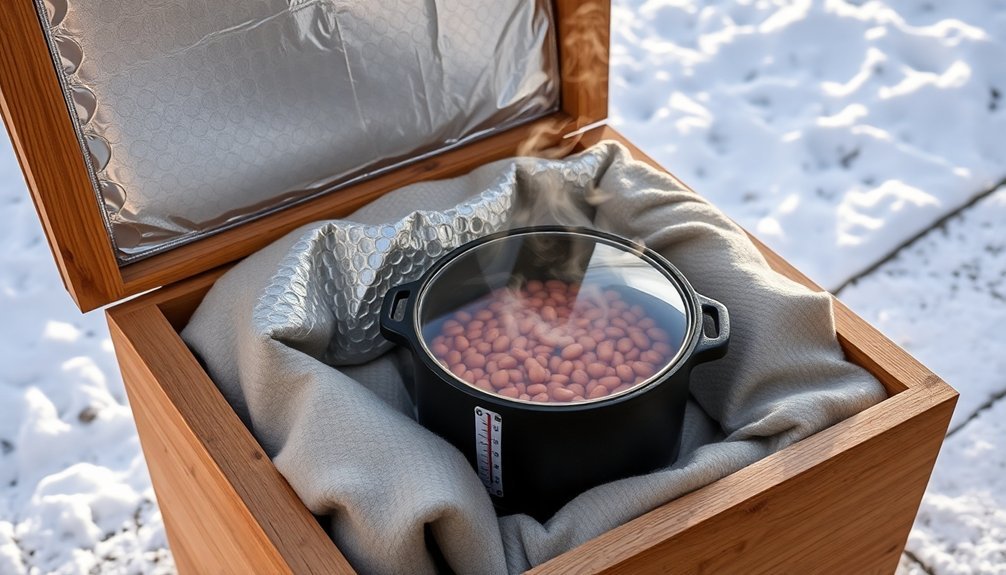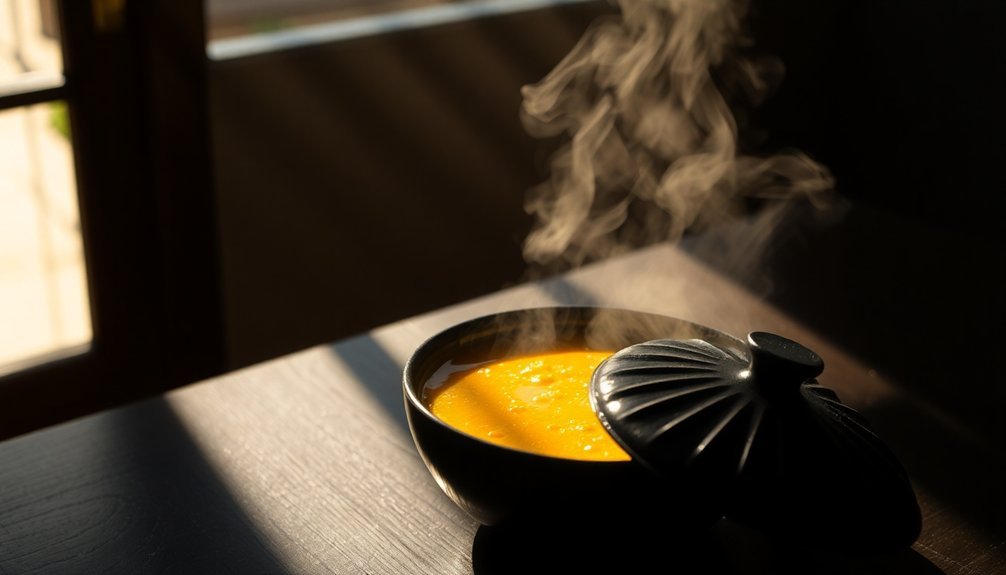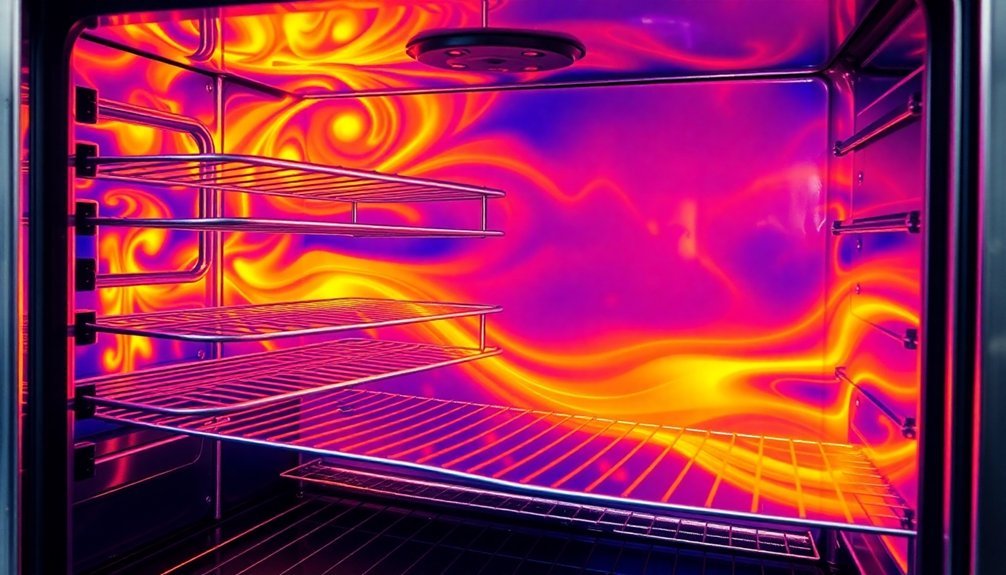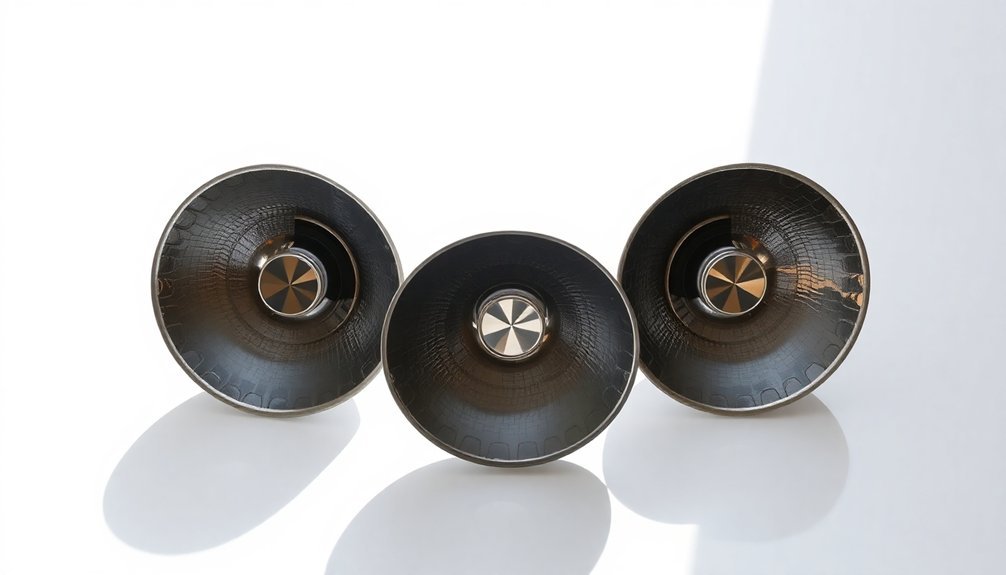To successfully cook beans using solar power in winter, you'll need to combine several key methods. Start by pre-soaking your beans overnight to cut cooking time in half. Position your solar oven in the sunniest spot and use double-layered plastic covers to trap heat. Choose dark-colored pots and add insulating materials like hay around them for maximum heat retention. Track the sun's movement every 30-45 minutes and consider a two-day cooking approach for challenging weather. Don't forget to maintain clean reflective surfaces and group multiple pots together for efficiency. These foundational techniques are just the beginning of your solar cooking journey.
Pre-Soaking for Winter Bean Success

The pre-soaking process stands as a critical first step for successful winter bean cooking with solar methods. You'll want to start by soaking your beans in unsalted water for at least 6 hours, though you can extend this overnight for convenience.
This preparation step will cut your cooking time by roughly 50%, which is especially important when using solar methods during shorter winter days. For optimal results, always use a dark colored pot when cooking beans in a solar oven.
You'll find that pre-soaking is particularly valuable for older beans that have lost moisture over time, ensuring they'll cook more evenly and maintain better texture. However, you'll need to be selective about which beans you soak. While chickpeas and cannellini beans benefit greatly from soaking, black beans mightn't require this step and could actually lose flavor.
If you're looking to maximize efficiency, don't feel pressured to soak beyond 6 hours, as extended soaking times won't substantially reduce cooking time further. Be careful not to over-soak, as this can lead to waterlogged beans.
For times when soaking isn't practical, you can consider alternatives like pressure cooking or using the thermos method, though these might affect your solar cooking strategy differently.
Positioning Your Solar Oven
Once your beans are properly soaked, success with winter solar cooking hinges on smart oven positioning. During winter's shorter days, you'll need to reposition your solar oven more frequently to maintain ideal sun exposure.
Start by placing your oven in the sunniest spot available, away from potential shadows and sheltered from harsh winds.
Maximize efficiency by adjusting your reflector angles with precision. Use a ruler to position aluminum foil reflectors, making sure they're smooth and flat to direct maximum sunlight into the cooking chamber. Using two layers of plastic around the lid opening helps retain valuable heat during cold weather.
You'll want to advance the oven's position throughout the day to track the sun's path, typically every 30-45 minutes during winter months.
Remember to insulate your solar oven properly to combat winter's chill. Monitor the internal temperature closely to maintain safe cooking levels for your beans.
If you're dealing with cloud cover, you'll need to extend cooking times accordingly. Don't forget to use potholders when checking on your beans, as the oven can still get quite hot even in cold weather.
Keep the reflective surfaces clean and well-maintained to facilitate optimal heat capture during limited winter daylight hours.
Timing Winter Solar Bean Cooking

Successfully timing your winter bean cooking requires careful consideration of several key factors. You'll need to account for shorter daylight hours and potentially cloudy conditions that can considerably extend cooking times.
Plan to start your beans early in the morning to maximize available sunlight, and be prepared for cooking times of 3-5 hours, depending on your bean variety. You can achieve optimal results by using dark-colored metal pots for cooking.
Pre-soaking your beans becomes especially vital during winter months, as it'll reduce your overall cooking time when sunlight is limited. You might need to adopt a two-day cooking strategy: partially cook your beans on the first day, refrigerate them overnight, and finish cooking the next day when conditions are favorable.
If you're at a higher elevation, you'll need to add extra time to your cooking schedule.
To optimize your winter bean cooking, consider batch cooking multiple portions when you have a clear day. You can freeze the extra portions for later use.
Keep checking your beans regularly throughout the cooking process, and adjust your solar oven's position to track the winter sun's lower arc across the sky. Remember to use an adjustable base to capture maximum sunlight at winter angles.
Bean Selection and Preparation
Selecting ideal beans marks your first essential step for winter solar cooking success. You'll want to choose fresh, high-quality beans from varieties like pinto, kidney, cannellini, black, or white beans. When you're shopping, look for beans that aren't over-matured and store them in a sealed container in a dry place until you're ready to use them.
Before solar cooking, you'll need to pre-soak your beans overnight, which substantially reduces their cooking time – an important consideration for winter solar cooking. To ensure optimal freshness, check that they snap when broken, as this indicates proper quality.
Start by washing the beans thoroughly to remove any dirt or debris. Then, place them in a dark-colored pot, which absorbs solar heat more effectively, and add water until it's 1-2 inches above the beans.
You'll want to cover your pot tightly to retain heat and steam during cooking. Since you're cooking in winter conditions, consider cooking larger batches that you can freeze for later use.
Remember that different bean varieties have varying cooking times, so you'll need to adjust accordingly. If you're cooking at higher altitudes, plan for extended cooking times and keep extra water handy for additions during the cooking process.
Heat Retention and Insulation

Keeping your beans cooking steadily during winter months depends heavily on effective heat retention and insulation techniques. You'll need to maximize every bit of available solar energy and prevent heat loss through strategic insulation methods.
Consider using a haybox or wonder box setup, which allows you to transfer your partially cooked beans from the solar cooker into an insulated environment where they'll continue cooking. Your beans will maintain optimal cooking temperatures since retained heat units typically only lose about 6-10 degrees per hour.
Create an effective heat retention system by:
- Lining your cooking container with dark-colored cookware to absorb maximum sunlight
- Packing insulating materials like hay or cushioning pads tightly around your cooking pot
- Shifting from solar to retained heat cooking before temperatures drop too low
When using a solar box cooker, you can improve efficiency by closing the reflective lid for larger bean batches or grouping multiple pots together with heated masses. Don't forget to monitor your beans' internal temperature with a thermometer to verify proper cooking.
If needed, you can move your insulated setup indoors once you've captured sufficient solar heat. For best results, pre-heat your solar cooker before adding beans, and test their doneness shortly before serving.
Frequently Asked Questions
Can Solar Ovens Be Used Effectively in Snowy Conditions?
Yes, you'll find solar ovens work effectively in snowy conditions as long as there's bright sunlight. You don't need warm temperatures, but you'll want to use well-insulated box cookers and adjust angles frequently.
What Alternative Heat Sources Can Supplement Solar Cooking on Cloudy Days?
You can supplement your solar cooking with biogas, rocket stoves, or thermos cookers on cloudy days. Electric cookers powered by stored solar energy and gas cookers also provide reliable backup heating options.
How Do Different Altitudes Affect Bean Cooking Times in Solar Ovens?
You'll need longer cooking times at higher altitudes since water boils at lower temperatures. For every 1,000 feet above 2,000 feet, add 5% more cooking time and make certain you're reorienting your solar oven frequently.
Does Air Pollution Impact Solar Cooking Efficiency During Winter Months?
Yes, air pollution substantially impacts your solar cooking in winter. You'll notice reduced efficiency when there's smog or haze, but you can actually get better results on clear winter days with clean air.
Can Frozen Beans Be Safely Thawed and Cooked in Solar Ovens?
Yes, you can safely thaw and cook frozen beans in solar ovens. You'll need to preheat the oven, monitor temperatures carefully, and guarantee quick heating through the danger zone to prevent bacterial growth.
In Summary
You've learned efficient methods for solar cooking beans during winter's challenges. By following proper pre-soaking techniques, strategic oven placement, and timing your cooking with peak sunlight hours, you'll achieve tender, delicious beans even in cold weather. Remember to choose appropriate bean varieties and maintain proper insulation. With these winter solar cooking tips, you're ready to create nutritious, energy-efficient meals year-round.





Leave a Reply